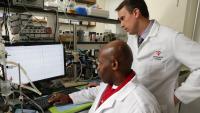Research

Mechanisms of Arrhythmia and Mitochondrial Dysfunction Caused by Cardiac Lipid Overload
The Morrow Lab’s major contributions to the field of cardiac biology have been to demonstrate that cardiac lipid overload (aka lipotoxicity) causes arrhythmia and sudden cardiac death from spontaneous ventricular tachycardia, using a transgenic mouse model (Heart Rhythm, 2016 and Circulation, 2011). The Morrow lab has also shown that wild-type diet-induced obese mice have increased ventricular ectopy and increased activation of several stress kinase pathway in the heart, causing hypertrophy and abnormalities of ion channel transcription (Journal of Molecular and Cellular Cardiology, 2013). Our most recent work has identified the mechanisms responsible for oxidative stress and mitochondrial dysfunction in cardiomyocytes exposed to saturated fat, and extended this work to in vivo, using mice fed a high-fat diet.
Molecular Mechanisms of Cardiomyopathy and Hypertrophy
In collaboration with laboratories at Temple University, we have proposed a novel approach to treatment of sepsis-induced cardiomyopathy. In a sepsis mouse model, we showed that blocking the activation of an enzyme NADPH oxidase 2 (NOX2) in the heart lowers oxidative stress and thereby allows cardiac energy production to return to near-normal levels. The findings suggest that NOX2 inhibition, used alongside existing sepsis therapies, could benefit patient survival (JCI Insight 2017).
The Morrow lab has also contributed to identifying the molecular mechanisms that lead to cardiomyopathy caused by muscular dystrophy, in collaboration with the Worman Lab (at Columbia) and the Muchir Lab (INSERM, Paris, France). In addition, the Morrow Lab has identified ERK-NFkB activation during cardiac hypertrophy as a critical regulator of SERCA transcription, which could be an important mechanism of arrhythmia and the transition from cardiac hypertrophy to heart failure.
Cardiac Ion Channel Regulation
Prior work focused on regulation of the BK channel, which is an important regulation of vascular tone, and the L-type calcium channel, which is the major calcium channel on the surface of cardiomyocytes. Ongoing efforts seek to identify the specific peptide sequences on the L-type channel that are responsible for adrenergic regulation of current, and to determine the role of late sodium current in the pathophysiology of atrial fibrillation. In collaboration with the Marx Lab, we have shown that an increase in sodium channel current in the heart is sufficient to cause atrial fibrillation (JCI 2016).
Mechanisms of Cellular Lipid Uptake and Post-Myocardial Function of Macrophage
Earlier work focused on cellular process that allows macrophage to take up lipids, which is important for atherosclerosis. In collaboration with the Thorp Lab, the Morrow Lab has also contributed to the role macrophage in post-myocardial infarction wound healing (JACC Basic to Translational Science, 2017, and Circulation Research, 2013).
Clinical Arrhythmia Research
In collaboration with cardiothoracic surgery and the heart transplant/LVAD group at Columbia University, the Morrow Lab has investigated the role of ICDs in treating ventricular tachycardias in patients with LVADs (JACC, 2013). We also have a pilot project to investigate metabolomics abnormalities in patients with atrial fibrillation, to gain insight into the metabolic causes of atrial fibrillation.